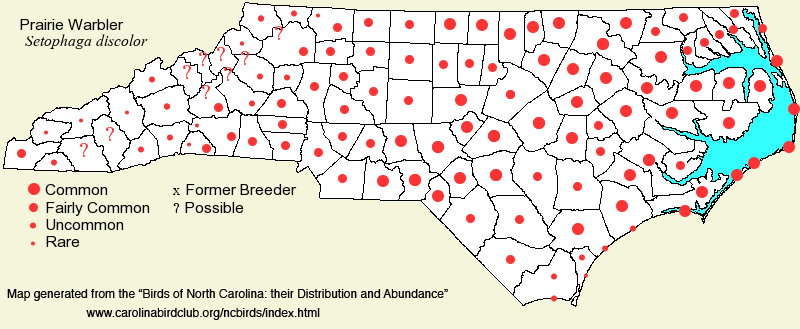 |  |
|
Prairie Warbler - Setophaga discolor PARULIDAE Members: | Search Common: Search Scientific: |
|
|
|||||||
| General Comments | The Prairie Warbler is another mis-named warbler, as it is not found in prairies (i.e., native grasslands), but in overgrown fields and other shrubby habitats. It nests in the eastern United States, and thus is present as a breeding species throughout the state, though is scarce in many mountain counties. Its numbers have declined in recent decades across its range, though in North Carolina numbers seem to have held steady; thus, declines appear to be mainly elsewhere. A few individuals linger along the southern half of the coast into early winter, and some of these probably do survive the winter. In the breeding season, the species favors maritime shrub thickets, younger (or recently-burned) pocosins, overgrown fields with saplings, recent clearcuts, and other sites where the woody vegetation is mostly under 15-20 feet high. An exception is the Great Dismal Swamp, where it nests in mature stands of Atlantic White Cedar, at least where mixed with hardwoods. In winter, birds are seen mainly in shrubs along the edges of brackish marshes, especially in stands of Waxmyrtle and Groundsel-tree (= Sea-myrtle). Birds also can be found in other shrubby areas in winter, well away from brackish water. | ||||||
| Breeding Status | Breeder | ||||||
| NC BRC List | Definitive | ||||||
| State Status | |||||||
| U.S. Status | |||||||
| State Rank | S5B,S1N | ||||||
| Global Rank | G5 | ||||||
| Coastal Plain | Summer resident, and sparse winter visitor/resident. In summer, common over most of the region, though only fairly common in the southern portions; also common along the Outer Banks. It can be very common in some pocosins/edges, such as at Alligator River NWR. In early winter, rare to uncommon along the southern half of the coast, and also rare along the margins of Pamlico Sound and at the Lake Mattamuskeet causeway; generally quite rare in these areas after mid-Jan, but some birds undoubtedly survive the winter. Mainly late Mar to early Nov near the coast; early or mid-Apr to late Sep or early Oct farther inland. Peak counts: 109, Dare mainland, 24 May 1995. | ||||||
| Piedmont | Summer resident. Fairly common to common in the eastern portions, and fairly common in the central sections; uncommon in the foothills. Mainly early Apr to mid-Sep. Four records in late Dec, with one record in Jan-Feb -- one at Clarks Creek Nature Preserve (Mecklenburg), 15 Dec 2019 - 26 Jan 2020 being notable. In the winter of 2020-21, one at the NC Zoological Park (Randolph) on 17 Jan was notable, as was one at Apex (Wake) from 16 Feb into the spring. Peak counts: | ||||||
| Mountains | Summer resident. Uncommon over the region, as a whole; essentially below 3,000 feet. Fairly common in the extreme southwestern counties, but can be rare in many counties because of their high elevations. Mainly mid-Apr to mid-Sep. One photographed at the NC Arboretum (Buncombe) was quite late on 2 Nov 2023. Peak counts: | ||||||
| Finding Tips |
The species is easily found in the Coastal Plain and eastern Piedmont. Driving US 264 through Alligator River NWR will yield them in abundance. **** | ||||||
| Attribution | LeGrand[2024-02-11], LeGrand[2023-04-08], LeGrand[2021-05-18] | ||||||
| NC Map Map depicts all counties with a report (transient or resident) for the species. | Click on county for list of all known species. |
| NC Breeding Season Map Map depicts assumed breeding season abundance for the species. |  |